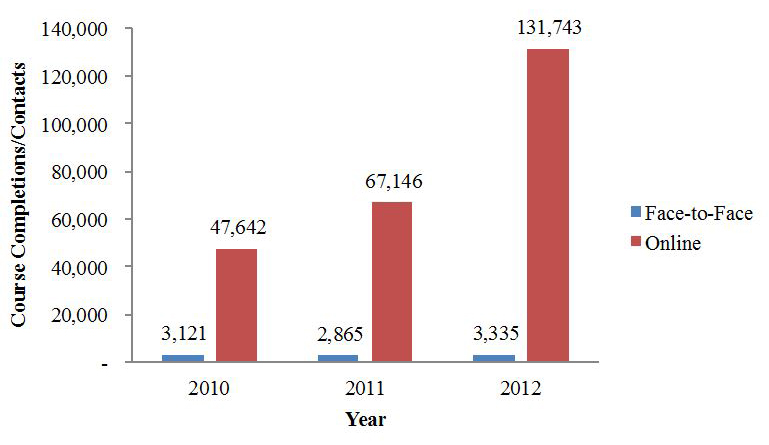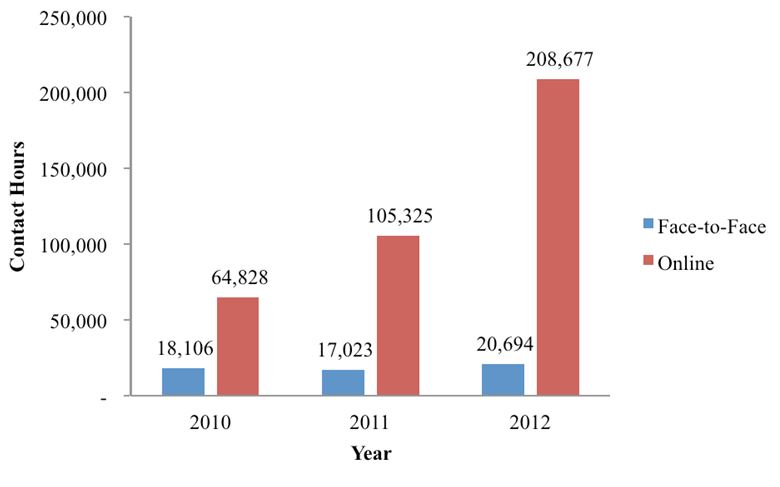 |
December 2013
|
December 2013 // Volume 51 // Number 6 // Tools of the Trade // v51-6tt4
Meeting a Growing Demand: Texas A&M AgriLife Extension Service's Early Childhood Educator Online Training Program
Abstract
Demand for professional development training in the early childhood field has grown substantially in recent years. To meet the demand, Texas A&M AgriLife Extension Service's Family Development and Resource Management unit developed the Early Childhood Educator Online Training Program, a professional development system that currently offers nearly 100 courses (142 contact hours) to child care professionals in multiple languages. Since 2010, over 300,000 online courses have been completed by child care providers and directors. Outcomes from the program demonstrate how technology can be used to augment Extension educators' face-to-face training efforts by dramatically expanding outreach to this growing audience.
Introduction
Extension educators have a long history of providing professional development training for child care providers and directors. Efforts have included offering face-to-face (F2F) trainings, distance learning seminars, newsletters, and fact sheets in print and electronic format (Hardison & Behnke, 2007; Ostergren, Riley, & Wehmeier, 2011; Walker, 2003). Recent advances in technology, however, have opened up additional opportunities for Extension educators to expand their outreach to this important segment of the workforce.
In the U.S., approximately 11 million children under age 5 spend regular time in child care settings such as public and private child care centers and family child care homes (Child Care Aware, 2012). More than 2 million individuals in the U.S. earn a living caring for these young children (Brandon, Stutman, & Maroto, 2010).
Results from longitudinal research conducted by the National Institute of Child Health and Human Development (NICHD) indicate that quality matters when it comes to child care. Children who receive high quality care during the first several years of life develop better language, math, and social skills; exhibit fewer behavior problems; and tend to be better prepared for entrance into school (Vandell et al., 2010).
Of the known factors that contribute to high-quality care, one of the most important is the professional training that child care providers receive prior to and during their employment in various child care facilities (NAEYC, 2009). Having a well-trained child care workforce is an integral part of providing the high quality care children need to reach their developmental potential.
Because of its vast network, subject-matter expertise, and commitment to improving the lives of children and families, Extension is well positioned to become one of the nation's foremost providers of professional development training for child care providers and directors. This article introduces readers to Texas A&M AgriLife Extension Service's Early Childhood Educator Online Training Program and demonstrates how such a system can augment Extension educators' F2F efforts by using technology to dramatically expand outreach to this growing audience.
Increased Demand for Professional Development Training
Currently, there are over 68,000 child care providers working in more than 23,000 centers and family child care homes in Texas (Child Care Aware, 2012). County Extension educators, state Extension specialists, and local partners have worked together for many years to provide F2F training to this audience through large-scale professional development conferences. Approximately 30 trainings are conducted annually, reaching more than 3,000 providers and directors. The trainings are research-based, offer best practice strategies to participants, and fulfill a vital training need.
Demand for training, however, has increased significantly over the years as state-mandated professional development requirements have changed. Providers in Texas are currently required to obtain 24 hours of training annually, while directors must obtain 30 hours. Recognizing the growing need for training, as well as the fact that local Extension educators have numerous demands on their time, specialists within Texas A&M AgriLife Extension Service's Family Development and Resource Management (FDRM) unit decided to develop an online course platform that would enable child care providers and directors to obtain additional training via the Internet.
Launching the Early Childhood Educator Online Training Program
In 2005, FDRM launched the Early Childhood Educator Online Training Program, an online portal that is a key component of the unit's broader online course platform, Extension Online (Green, 2012). The program makes online courses available to early childhood educators, not only in Texas, but also throughout the U.S. and internationally. What began with just a few course offerings has now grown into a system that offers nearly 100 courses (142 contact hours) in English, Spanish, and Vietnamese.
Courses for child care providers and directors are divided into the following categories:
- Child Health
- Child Growth and Development
- Guidance and Discipline
- Developmentally Appropriate Activities
- Preventing, Recognizing and Reporting Child Abuse and Neglect
- Observation and Assessment
- Safety in the Child Care Setting
- Professional Development
- Transportation Safety
- Sudden Infant Death Syndrome, Shaken Baby Syndrome, and Brain Development
Texas A&M AgriLife Extension Service's online courses are developed by subject matter experts and are based on the latest research and best practices in the above fields. Courses, which range from 1-2 hours in length, include downloadable copies of course handouts, audio and/or video narration, interactive activities, and printable certificates of completion containing a unique verification code. Mastery of course content is determined by participants' pre- and post-test scores.
Designed to provide maximum flexibility to users, the online program allows students to enroll in and/or complete courses anytime, day or night. Students can complete courses with virtually no instructor involvement; however, an online help desk is available if participants have technical difficulties or questions concerning course content. Each student who registers in the system and completes courses can access a printable transcript that contains the titles of courses completed, length of courses, final scores, and dates of completion.
Program Outcomes
Since 2010, over 300,000 online courses have been completed by child care providers and directors in the U.S. To illustrate the demand for online training, Figure 1 shows a comparison of online course completions versus F2F contacts (i.e., participants who attended trainings in person) over a 3-year period.
Figure 1.
Online Course Completion vs. F2F Contacts (2010-2012)

Demand for online training has continued to grow as illustrated by the 96% increase in online course completions from 2011 to 2012. Moreover, online course completions are on pace to reach 152,388 by the end of 2013 if monthly averages hold.
Looking at the data from a different angle, Figure 2 shows a comparison of contact hours completed by child care professionals online versus F2F. Even though F2F training conferences tend to be much longer in duration (e.g., 4-8 hours), clock hours completed online are substantially higher (208,677 vs. 20,674 in 2012).
Figure 2.
Online vs. F2F Contact Hours (2010-2012)

Outcomes from the program demonstrate that technology can be used effectively to dramatically expand outreach to child care professionals, while augmenting local Extension educators' F2F training efforts.
For More Information
To learn more about Texas A&M AgriLife Extension Service's Early Childhood Educator Online Training Program, go to http://childcare.tamu.edu, or e-mail Dr. Stephen Green at s-green@tamu.edu.
References
Brandon, R. N., Stutman, T. J., & Maroto, M. (2010). The economic value of the U.S. early childhood sector. In E. Weiss & R.N. Brandon (Eds.) Economic analysis: The early childhood sector (pp. 19-41). Washington, DC: Partnership for America's Economic Success.
Child Care Aware (2012). Child Care in America: 2012 state fact sheets. Retrieved from: http://www.naccrra.org/publications/naccrra-publications/2012/6/child-care-in-america-2012-state-fact-sheets
Green, S. D. (2012). Extension online: Utilizing technology to enhance educational outreach. Journal of Extension [On-line], 50(5) Article 5TOT4. Available at: http://www.joe.org/joe/2012october/tt4.php
Hardison, W. J., & Behnke, A. O. (2007). Creative solutions for emerging child care needs. Journal of Extension [On-line], 45(1) Article 1IAW3. Available at: http://www.joe.org/joe/2007february/iw3.php
National Association for the Education of Young Children (2009). Developmentally appropriate practice in early childhood programs serving children from birth through age 8. Retrieved from: http://www.naeyc.org/files/naeyc/file/positions/PSDAP.pdf
Ostergren, C. S., Riley, D .A., & Wehmeier, J. M. (2011). Better kid care program improves the quality of child care: Results from an interview study. Journal of Extension [On-line], 49(6) Article 6FEA10. Available at: http://www.joe.org/joe/2011december/a10.php
Vandell, D. L., Belsky, J., Burchinal, M., Steinberg, L., Vandergrift, N., & NICHD Early Child CareResearch Network. (2010). Do effects of early child care extend to age 15 years? Results from the NICHD study of early child care and youth development. Child Development, 81(3), 737–756.
Walker, S. K. (2003). Building a state child care initiative: Applying principles of teamwork and collaboration. Journal of Extension [On-line], 41(3) Article 3FEA2. Available at: http://www.joe.org/joe/2003june/a2.php




